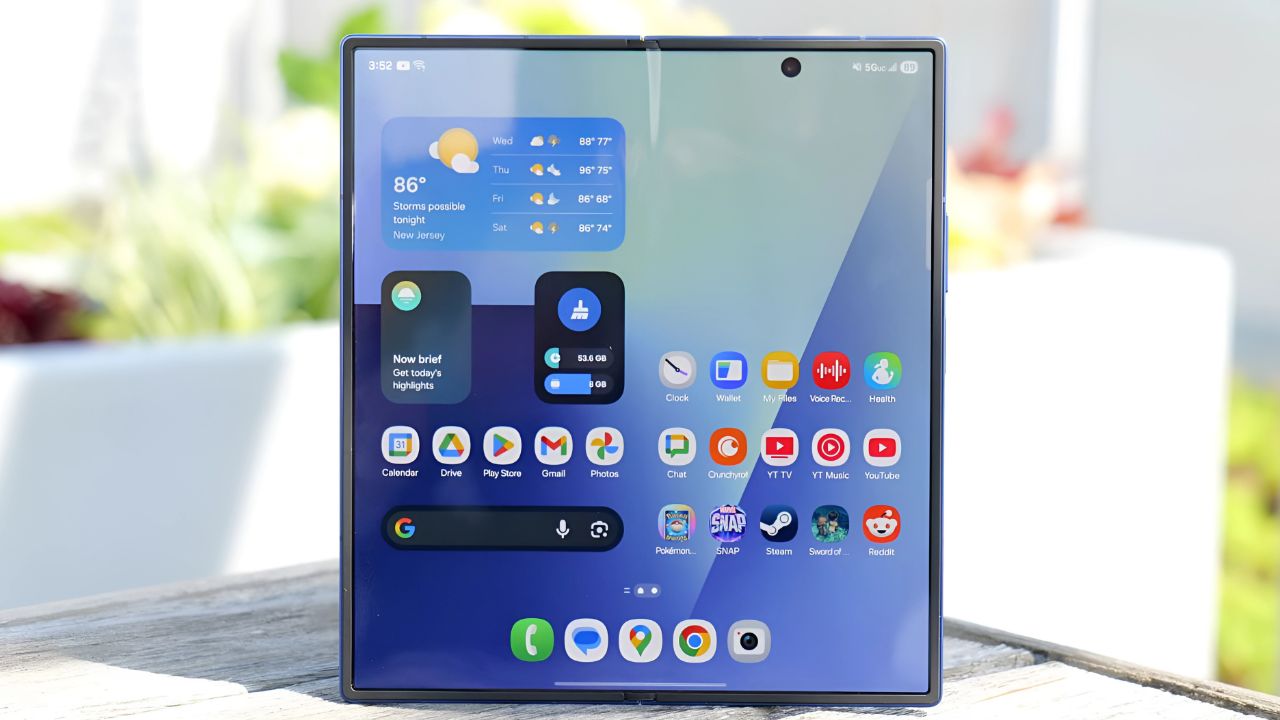If you’re thinking about upgrading to a foldable phone, you might want to pay attention to some surprising news about Samsung’s future plans. The Galaxy Z Fold 7 has barely hit the shelves, but rumors are already swirling about its successor – and they’re not all good news.
The Titanium Advantage That Made Z Fold 7 Special
Samsung made a big deal about the Galaxy Z Fold 7’s titanium backplate, and honestly, they had good reason to. This isn’t just marketing fluff – the titanium construction actually makes a real difference in how the phone feels and performs.
Think of the backplate as the phone’s backbone. It’s what supports that impressive inner folding display and works alongside the hinge mechanism to make those smooth fold-and-unfold motions possible. When Samsung switched to titanium for the Z Fold 7, they weren’t just trying to sound fancy – they were solving real problems.
The results speak for themselves. Independent testing showed that the Z Fold 7 can handle an incredible 500,000 folds before showing signs of wear. That’s 50% more than what the Z Fold 6 could manage with its older design. For context, if you folded and unfolded your phone 100 times a day (which would be quite a lot), you’d still be looking at over 13 years of use.
Why Samsung Might Step Backwards with Z Fold 8
Here’s where things get concerning for anyone hoping Samsung would keep pushing the envelope. Reports suggest that Samsung is seriously considering ditching the titanium backplate for the Galaxy Z Fold 8 and going back to carbon fiber-reinforced plastic (CFRP) – the same material they used from the Z Fold 3 through the Z Fold 6.
The Real Reason Behind This Potential Change
This isn’t about Samsung suddenly deciding that plastic is better than titanium. The driving factor appears to be geopolitical and economic. Sourcing titanium components from China is becoming increasingly complicated, especially with potential tariff changes on the horizon. When international trade gets messy, phone manufacturers often have to make compromises they’d rather avoid.
From a business perspective, you can understand Samsung’s dilemma. They need to keep costs reasonable and supply chains stable, even if it means taking what looks like a step backward in materials.
What This Means for Your Next Phone Purchase
The Durability Question
If Samsung does revert to CFRP for the Z Fold 8, you’re probably looking at a phone that won’t be quite as robust as the Z Fold 7. That doesn’t mean it’ll be fragile – the Z Fold 6 and earlier models held up reasonably well for most users. But if you’re the type of person who’s hard on their devices, or if you plan to keep your foldable for several years, that extra durability could matter.
The S Pen Situation Gets Interesting
Here’s an unexpected twist: going back to plastic might actually bring back a feature that many users missed. The titanium in the Z Fold 7 creates interference with stylus signals, which is why Samsung had to drop S Pen support. If they return to CFRP for the Z Fold 8, stylus support could make a comeback.
But before you get too excited about this possibility, Samsung is reportedly working on new stylus designs that could work even with titanium. So the S Pen situation might resolve itself regardless of which material they choose.
Should You Buy the Z Fold 7 Now or Wait?
The Case for Buying Now
If premium materials and maximum durability are important to you, the Galaxy Z Fold 7 might be your best bet. You’re getting that titanium construction that Samsung may not offer again for a while. Plus, the phone is available for pre-order right now with some solid deals.
The Z Fold 7 represents Samsung’s current peak engineering for foldables. Everything from the thinner profile to the improved durability testing results shows a company that was really focused on building the best possible device, cost and complexity aside.
The Case for Waiting
On the other hand, if you’re not particularly concerned about having the absolute premium materials, waiting might make sense. The Z Fold 8 could potentially be less expensive due to cheaper materials, and you might get S Pen support back.
There’s also the simple fact that technology keeps advancing. Whatever improvements Samsung makes to the Z Fold 8 in terms of cameras, processors, or software features might outweigh the materials downgrade for many users.
The Bigger Picture for Foldable Phones
Industry Pressures Are Real
This situation with Samsung illustrates something important about the current state of technology manufacturing. Even the biggest companies have to navigate complex international relationships, supply chain challenges, and cost pressures. Sometimes that means making compromises that pure engineering wouldn’t dictate.
What This Means for Competition
Samsung’s potential step backward with materials could create opportunities for other foldable manufacturers. If Google, OnePlus, or other brands can secure reliable titanium supplies, they might be able to position their foldables as more premium alternatives.
Making Your Decision
The Galaxy Z Fold 7 versus waiting for the Z Fold 8 isn’t a simple choice. You’re weighing current premium materials and proven durability against potential future features and possibly lower costs.
If you’ve been waiting for the right time to jump into foldable phones, the Z Fold 7 might represent a sweet spot – it’s got the premium construction that might disappear next year, but it’s available right now with current-generation performance and features.
Whatever you decide, just remember that these are still early days for foldable technology. Whether you choose titanium durability today or wait for whatever innovations come next year, you’re participating in one of the most exciting chapters in smartphone evolution.
